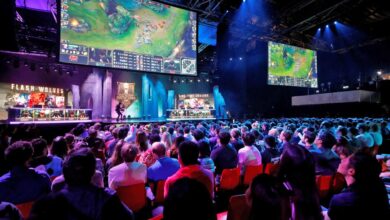Next-Gen Gaming Consoles Blend Reality and Virtual World

In the ever-evolving world of 2025, the heart of the gaming universe beats within the next generation of consoles. These machines are far more than just boxes for playing games; they are the epicenters of interactive entertainment, redefining what’s possible in terms of graphics, speed, and immersive experiences. The fierce rivalry between industry titans is pushing the boundaries of technology, bringing us closer to a future where the lines between reality and a virtual world are blurred. This comprehensive guide will take you on an in-depth journey to explore the features, philosophies, and future of the latest gaming consoles. We will delve into the technical specifications that power them, the innovations in user experience, and the strategic decisions that will shape the next decade of gaming. By the end of this article, you will have a clear and actionable understanding of what these powerful machines offer and what they mean for the future of interactive entertainment.
The Core Technology

A console’s power is measured not just in teraflops but in its ability to create a seamless, high-fidelity experience. The latest consoles are built on a foundation of cutting-edge hardware designed to eliminate loading screens and push graphical boundaries.
A. The Processor and Graphics Card
The CPU and GPU are the engines of the console. Their combined power is what determines the resolution, frame rate, and graphical fidelity of a game.
- Custom-Built Silicon: Both industry leaders have invested heavily in custom-built silicon, with a focus on deep integration between the CPU and GPU. This allows for a more efficient flow of data, reducing bottlenecks and enabling faster performance.
- Ray Tracing: Ray tracing is a new technology that simulates how light bounces off objects in a real-world environment. It creates incredibly realistic lighting, reflections, and shadows. The latest consoles have dedicated hardware for ray tracing, allowing for stunning, cinematic visuals in real time.
- High Frame Rates: The new consoles are capable of running games at a high frame rate, even up to 120 frames per second (fps). A higher frame rate creates a smoother, more responsive experience, which is a major advantage for fast-paced competitive games.
B. The Storage
One of the most significant innovations in the new consoles is the move to a high-speed Solid State Drive (SSD).
- Blazing-Fast Loading: A high-speed SSD can load game assets in a fraction of the time it takes a traditional Hard Disk Drive (HDD). This has virtually eliminated loading screens, allowing for a more seamless and uninterrupted gaming experience.
- Streaming of Assets: The speed of the SSD also allows for a new kind of game design where assets can be streamed into the game world in real time. This means that developers no longer have to build smaller, more contained levels to account for slow loading times.
C. The Audio
Audio is a key component of an immersive gaming experience. The latest consoles have dedicated hardware for 3D audio.
- 3D Audio: 3D audio simulates sound from all directions, including from above and below. It creates a more realistic and immersive soundscape, which is a major advantage for horror games and for competitive games where hearing the location of an enemy is critical.
- The Audio Engine: A dedicated audio engine offloads the processing of complex audio from the CPU, allowing for a richer, more detailed soundscape.
The Next-Gen User Experience

The new consoles are not just about raw power; they are about a more streamlined and social user experience that breaks down the barriers between games and between players.
A. The User Interface
The new user interfaces are designed to be fast, intuitive, and highly personalized.
- Blazing-Fast Navigation: The new UIs are designed to be incredibly fast and responsive, with a focus on getting you into your game as quickly as possible.
- Activity Cards: The new UIs also feature “activity cards” that show you key information about your games, from new quests to social updates. This allows you to jump directly into a specific part of a game without navigating through the main menu.
- Cross-Platform Social: The new social features are designed to be more integrated and seamless. You can now easily join a party chat with friends on a different console, creating a more open and connected gaming community.
B. The Controller
The controller is your primary interface with the game. The latest controllers have new features that create a more immersive and tactile experience.
- Haptic Feedback: Haptic feedback is a more advanced form of vibration that can simulate a wide range of sensations, from the rumble of an engine to the feel of a bowstring being pulled.
- Adaptive Triggers: The adaptive triggers on the new controllers can change their resistance to simulate a wide range of actions. For example, a trigger might get harder to pull as you fire a shotgun or as you pull on a rope.
C. The Subscription Model
Both industry leaders are heavily invested in a subscription model.
- Massive Game Libraries: A subscription service gives you access to a massive library of games for a single monthly fee. This is a great way to discover new games and a great value proposition for gamers who play a wide variety of titles.
- First-Party Games on Day One: Some subscription services now offer access to their first-party games on the day they are released. This is a powerful selling point that could change the way we buy games in the future.
The Future of Gaming
The next-gen consoles are just the beginning. The future of gaming promises an even deeper integration of technology with our daily lives.
- Cloud Gaming: The next generation of consoles will likely have a much deeper integration with cloud gaming services. This will allow you to play your games on almost any device, from your laptop to your smartphone.
- The Metaverse: The metaverse is emerging as the ultimate virtual world. The new consoles will be a key gateway to this metaverse, providing a powerful platform for social experiences, virtual events, and a new kind of interactive entertainment.
- AI-Powered NPCs: The next generation of games will have AI-powered NPCs (non-player characters) that are more intelligent and more realistic than ever before. This will lead to a new level of immersion and a more dynamic and unpredictable game world.
- More Accessible Gaming: The new consoles are designed to be more accessible to a wider audience, with a focus on a more intuitive user experience and a powerful subscription model that makes gaming more affordable. This is a major step toward democratizing access to interactive entertainment.
Conclusion
The next-gen gaming consoles are not just an incremental upgrade; they are a fundamental leap forward in what is possible in interactive entertainment. They are a fusion of raw power, intelligent design, and a commitment to a more social and connected user experience. The journey to a fully realized next-gen console ecosystem is an ongoing one, with a focus on a high-fidelity experience, an end to loading screens, and a more intuitive and seamless user interface.
The strategic decisions that are being made today—from the move to a high-speed SSD to the rise of a powerful subscription model—are shaping the future of gaming. The console wars are coming to an end, replaced by a new kind of rivalry based on the quality of the service and the richness of the game library. By embracing this new paradigm, the gaming industry is poised for an unprecedented period of growth and innovation. The future of gaming is here, and it’s more exciting than ever before.


